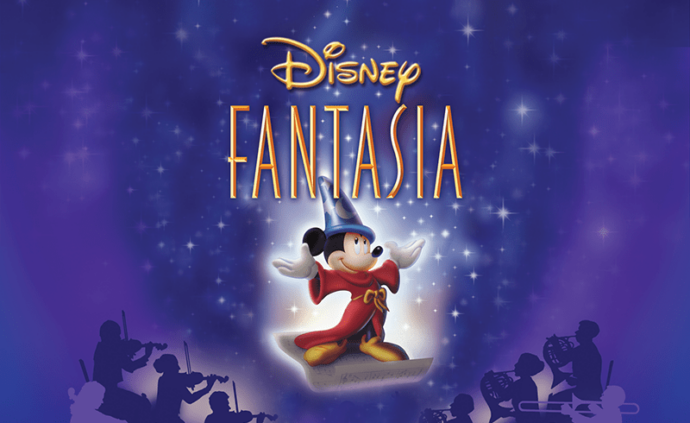Plus or Minus is a series detailing and analyzing every feature film now streaming on Disney+. It combines the unique history all these films share, their cultural impacts, and their qualities, or lack thereof. From timeless classics, to acquired hits, to DCOMs, no stone will be left unturned.
This next part of Plus or Minus, focusing on 1940’s Fantasia, will be a touch different. Typically I begin these by summarizing the plot itself. However, Fantasia doesn’t have a plot. At least, a plot that follows typical conventions. Instead, Fantasia is in fact several stories packed into an anthology format. And even then, not all of the stories told can really be explained in a written format.
For those unaware, Fantasia was a unique experimental piece from Walt Disney combining classical music with Disney animation. With live-action sequences of Deems Taylor introducing each piece, Fantasia serves as a music concert that creates vignettes with their own visuals, stories, and ideas. From the dramatic to the lighthearted. From the cruel to the whimsical.
Where Did This Come From?
The idea for Fantasia came from a yearn from Walt to keep Mickey Mouse relevant. Yes, really. Out of fear his mascot was losing relevancy in the animation market, Walt developed a short titled The Sorcerer’s Apprentice. Based on the Johann Wolfgang von Goethe poem of the same name, this takes the story with Mickey Mouse as its star. The other hook? A composition of the orchestral piece of the same name, written by Paul Dukas.
While not the first Disney short to be animated over classical music, this was by far the most ambitious. For example, Walt asked famed Philadelphia Orchestra conductor Leopold Stokowski to conduct the music. Walt also put in as much funds as possible for this short to make it both grand and epic.
However, this came at a heavy cost. Literally. The budget soared higher and higher, three to four times greater than the usual Silly Symphony short. There was no way it could see a profit. This resulted in a creative pivot. Instead of one short focusing on one musical arrangement, it would be several shorts built around classical pieces. An animated concert as it were. And thus, one of the greatest achievements in animation was born.
So allow me to look at each segment on their own.
Toccata and Fugue in D Minor
This segment is by far the one with the least reliance on plot. Instead, it begins with the live-action orchestra, illuminated in gold and blue colors. And as the music continues, it transitions to an abstract spectacle.
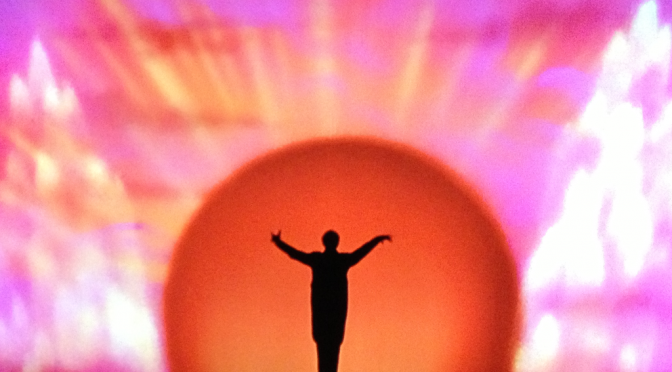
Lines, shapes, and clouds move through the music, change colors, disappear, all through the rhythm of the piece. It’s as if these patterns are what your mind sees when hearing the music on its own with no visuals.
It’s an ambitious piece for sure. And it’s definitely well-done. The abstract moments are creative and it’s clear there was real thought put into each moment. Yet despite being well-made, it is arguably the weakest of the segments.
Simply put, abstract images like these can’t be exact from person to person. They can’t recreate people’s true thought process As much as Disney’s animation team tries, it’s inherently limited to one’s own limitless imagination.
Regardless, still distinct and a solid piece to begin the procession.
The Nutcracker Suite
Tchaikovsky’s famous tunes depict the changing of the seasons. Spring begins with fairies flying through the meadow at the crack of dawn. They leave behind a trail of dew upon the flowers. Appropriately enough, “Dance of the Sugar Plum Fairy” plays. The colors here are exubrant. The distinct heavenly glow upon the blue, pink, and green fairies is gorgeous, and the dew on display pops. It’s astonishing to see such brightness pop up, enhancing the design of the meadow all at just the right time.
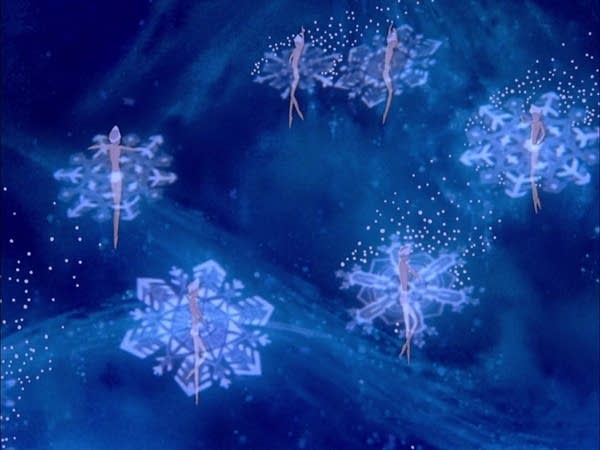
The magical dew of the fairies transitions to the “Chinese March” with a series of mushrooms, one of which always one step behind. It’s very unfortunate, as the mushrooms move and are designed like the frankly racist caricatures of Chinese people. Understandably, this may be the one segment that people may have issue with, but it is thankfully not very long.
This then leads to “Dance of the Reed Flutes.” As the blossoms begin their growth. The flowers dance along the water before transitioning into the shape of ballerinas. The colors, once again, are the stars here. Seeing the distinct hues dancing across the river is a lovely sight, and comfortably leads to the next segment.
A series of goldfish then swim across the ocean blue to the theme of “Arabian Dance”. Thankfully the racial stereotypes are less prominent, though sadly not completely gone. However, it’s lovely to see the Disney animation team play around with the underwater world they created. Both in terms of design and aesthetics. It’s also fun to see the fish move around.
Moving to the summer, next is “Russian Dance”, where a series of orchids, many dressed like Russian peasant girls, dance to the most lively and energetic piece of the bunch. It’s another showcase of the incredible colors on display and the energy Disney’s animation team were capable of.
But of course, summer leads to fall and fall leads to winter. The sugar plum fairies return, turning the leaves orange with a simple touch. Later on, the fairies bring frost to the leaves, grass and river, with them gliding on the water as if it was magic. Winter comes and finally ends this majestic piece.
It’s a moving piece with a very strong plot. While not necessarily a character study, seeing all four seasons unfold is oddly emotional. It’s nature itself, enchanting and enrapturing as ever. And there’s something so majestic seeing the plants come to life or even just seeing the leaves fall. Easily one of the best.
The Sorcerer’s Apprentice
The one that created this very film in the first place. Frustrated over being under the wing of the powerful sorcerer Yen Sid and only allowed to carry pails of water, Mickey Mouse brings a broom to life with the help of Yen Sid’s magic hat. He commands the broom to do his bidding, using almighty power that he selfishly should not use. But his laziness comes at a great cost.
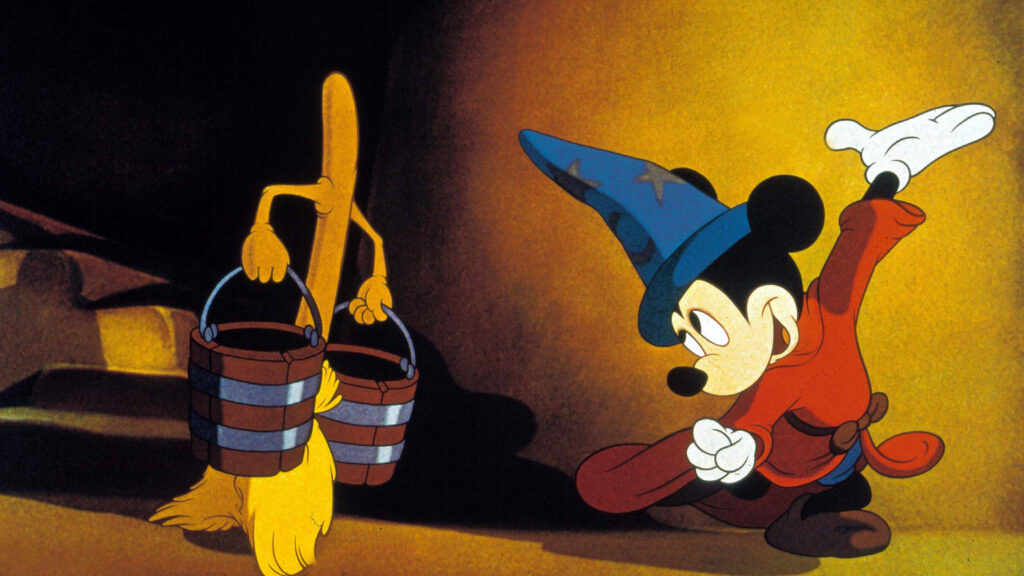
This is the most iconic segment of the film. Mickey in his sorcerer get-up is on every poster, and would go on to be one of the mouse’s most famous depictions. And it’s easy to see why. The story is a very simple cautionary tale of the abuse of power, through the lens of Disney’s mascot. It’s a real treat to watch, as it plays into Mickey’s more mischievous side. The music swells, playing well with the story. After all, as Deems Taylor mentions, the music came after the poem.
Perhaps the strongest moment of this segment is the climax. After Mickey attempts to stop the broom from flooding the chamber through murder via axe, the brooms multiply. Sure enough, the room is flooded with more and more water. The music becomes crazier and crazier, and once Yen Sid arrives, the one true bombastic note upon his entrance brings so much triumph to the segment as a whole. It’s no wonder Walt was adamant on making this Silly Symphony a glorious feat for Mickey.
Truly a masterpiece that deserves more love than simply being where Sorcerer Mickey comes from.
Rite of the Spring
This combines Igor Stravinsky’s music with the beginnings of the Earth itself. Starting with the Big Bang, we start seeing the Milky Way galaxy, then evolving into a series of volcanoes. After the volcanoes, an epic rain shower emerges and we see the beginnings of the microorganisms. Then, the oceans start rising, fish turning into amphibians, and the reign of the dinosaurs. And in perhaps the most tragic end, the destruction of the dinosaurs themselves.
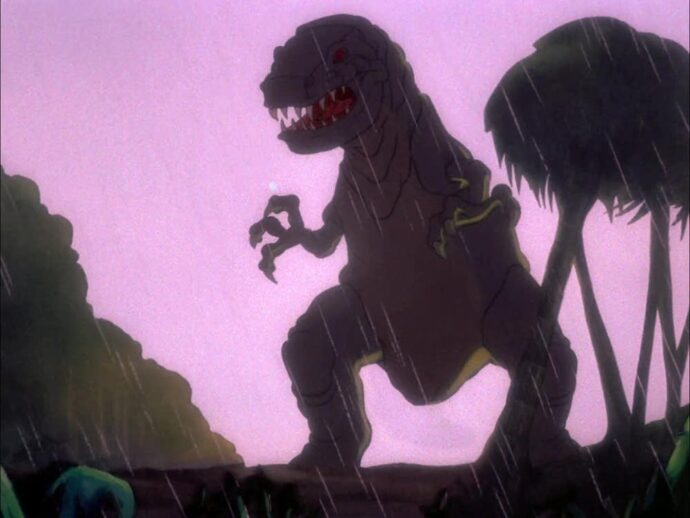
There’s a lot to like here, especially when it comes to the dinosaur portion. Their movements and mannerisms are realistic and engaging to follow, and the backgrounds are gorgeous. I believe watercolors were used here, and it’s a great contrast to the realism of the dinosaurs themselves. To say nothing of the Tyrannosaurus Rex sequence.
Yet at the same time, this is perhaps my least favorite of the bunch. Tocatta & Fugue doesn’t quite work as well as intended, but the abstract nature was at least distinct. Apart from the dinosaurs, the other moments, while not bad, don’t quite excel in terms of the creativity or aesthetics on display. However, it’s still well-done and has plenty to offer.
With these kinds of anthology films, there’s bound to be one you’re not as hooked on. But thankfully, this is still engaging enough, though overshadowed by the rest.
Intermission
Yes, this has an intermission to it. And it’s a good one. After a brief title card, there’s a free-form jazz session with some of the musicians. This then leads to Deems Taylor introducing “the soundtrack”, a simple white line. The line then changes into different colors and shapes as the music begins to play. It’s a cute little moment that gives the film even more character.
The Pastoral Symphony
This segment takes Roman mythology and places it upon the famed Beethoven piece. Fauns, unicorns, Pegasuses, centaurs and gods flood the screen, detailing an incredible ceremony held by Bacchus, the god of wine.
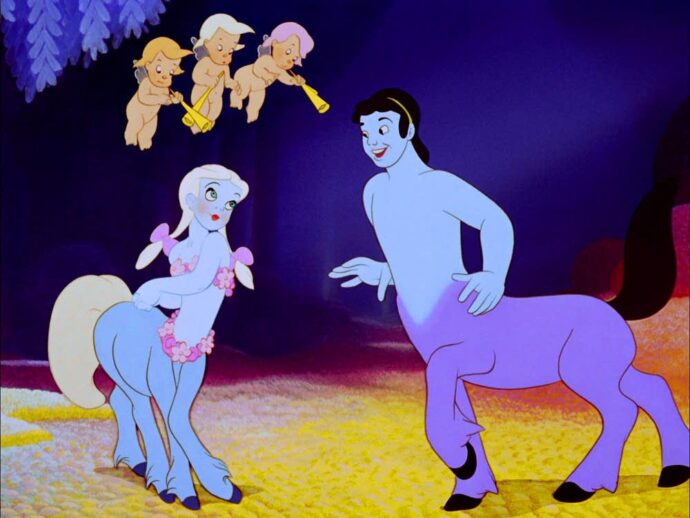
This just might be my personal favorite of the piece. Not just because of Beethoven’s incredible music, but the designs and colors used are sublime. It’s a landscape full of bright, pastel-like colors that are fantastic to behold. The centaurs are particularly great, in both their designs and mannerisms.
As for the gods themselves, they are also fun. Bacchus is of course a clumsy drunk, which has plenty of fun comedy to contrast with the music. Zeus, the god who destroys the celebration just for kicks, also brings some comic destruction that is gorgeous to see unfold. To say nothing of the triumphant note at the end, helped by Artemis shooting her bow through the sky.
Dance of the Hours
By far the most comedic piece of the feature. Following a piece composed by Amilcare Ponchielli, this divides itself into four sections. Each one features one group of animals, and represents a part of the day. A group of ostriches begin this session, representing the morning. They squabble among themselves, flying across the stage due to their long legs. Afternoon then comes, represented by a series of dancing hippos, dancing slowly and gracefully, symbolizing the speed, or lack of, during a lazy afternoon.
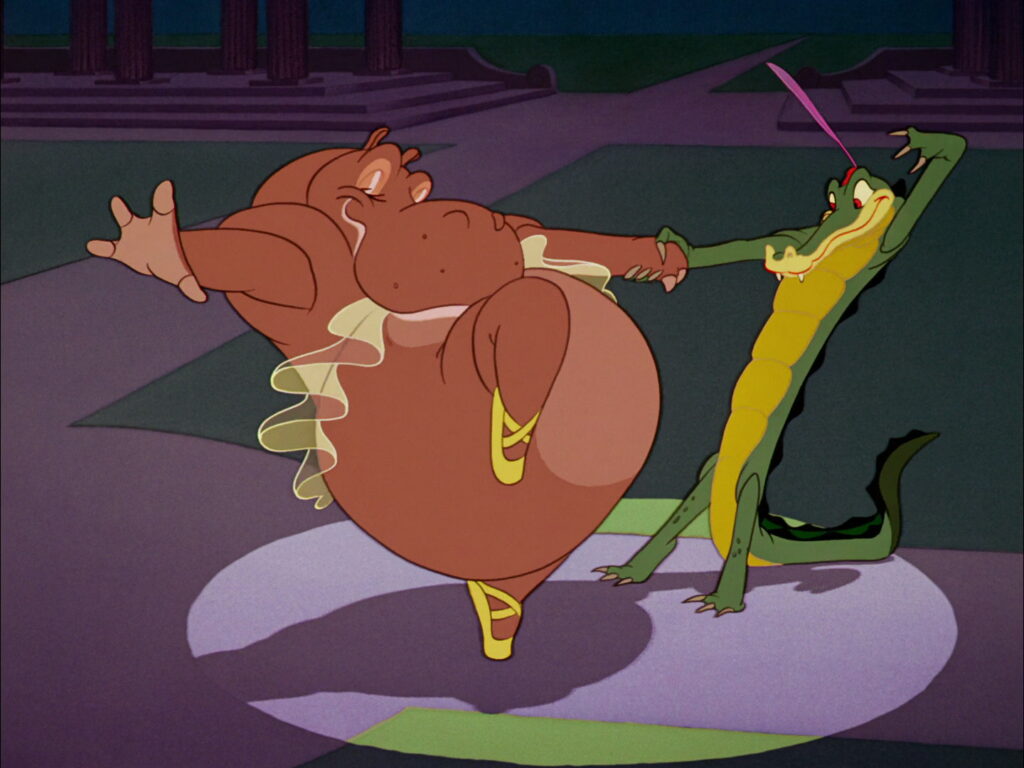
Evening soon emerges with a trio of elephants, quietly performing their routine, blowing bubbles out of their trunks, so as to not wake up the leader of the hippo troupe. It’s a clever idea, bringing in the idea that the evening quietly sneaks up on us until we’re unaware it has come. This of course leads to night, led by a troupe of alligators. Their slender forms allow them to move swiftly, crowding around the leader of the afternoon set.
All of this of course leads to an epic finale that sees all four troupes combatting against one another in pure mayhem. It’s cartoony for sure, but there’s still an elegance and respect here that allows this to still feel like a mature take on the source material. And this light piece all leads up to the final, darkest piece.
Night on Bald Mountain/Ave Maria
Chernabog, a devilish creature of the night, has awakened. And with his awakening come his minions. Imps, ghosts and demons fly through the night, bringing hellfire and mayhem to the land. The darkness, both of the nighttime and of Chernabog himself, is horrifying. The designs bring about foreboding dread and it’s haunting imagery all throughout.
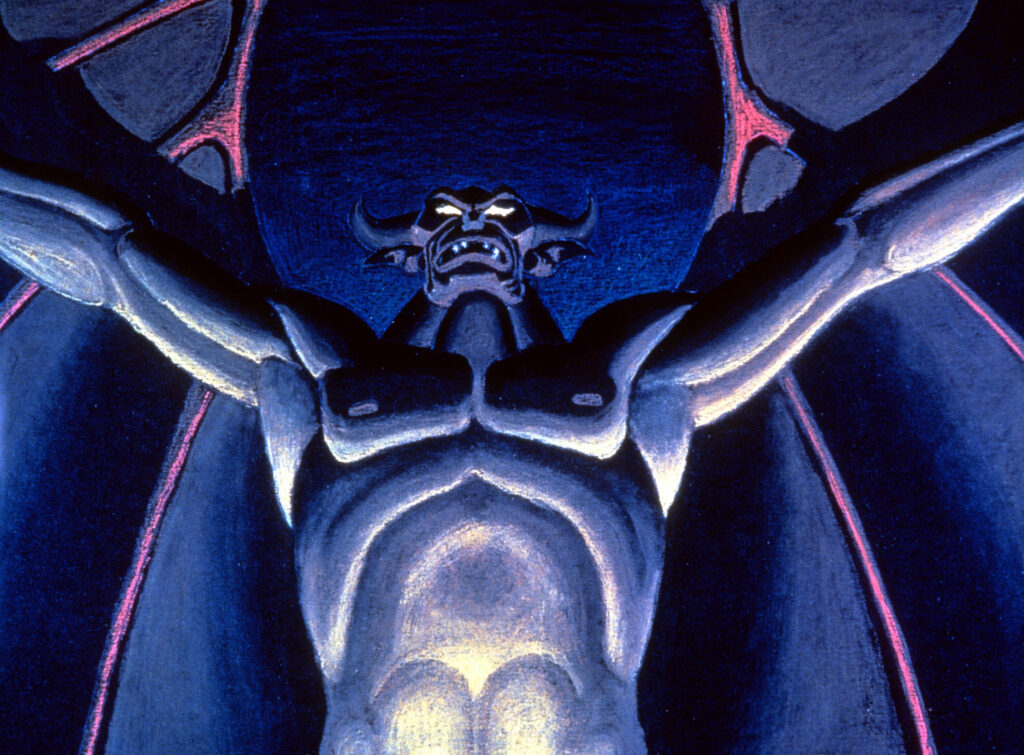
And that darkness then leads to perhaps the most beautiful moment in the whole film, the Ave Maria. An Angelus bell plays, destroying Chernabog’s fury. And as dawn breaks, a group of clergymen walk along, carrying lighted torches through the forest and into an abandoned cathedral.
It’s a moving moment for sure, showcasing the quality of piety through a moment illuminated by watercolors and contrasting a moment full of evil and hellish footage. Hearing the dulcet tones of Ave Maria makes it hard not to tear up, even if one may not follow Christianity or even religion. And as a final piece, it truly showcases what Fantasia is all about. A celebration of the power of music, and its values in our culture, through the guise of Disney animation.
Plus or Minus?
To this day, no other movie is like Fantasia. Even in spite of it having a literal sequel, which we’ll get to when I reach the year 2000 (assuming global warming doesn’t kill us all first), that film is still a bit of a departure from Fantasia. A concert/anthology film that takes classical music and places it under mature Disney animation would just not be greenlit in today’s climate.
And that makes me love the film even more. This is a film that combines the majesty of animation in a way that celebrates the medium for its creativity and talented artists. It allows fantastic music to be displayed in a film that prides itself upon incredible colors, astonishing motion, and creativity across every frame. Walt Disney, Leopold Stokowski, Deems Taylor, and their crews truly created something magical here.
It is without question, when choosing between Plus or Minus, that Fantasia is a Plus in every way shape and form.
Next time: The Reluctant Dragon is half-documentary, half-animated feature. It also…bends history a bit. We’ll see whether this earns Plus or Minus next week!
